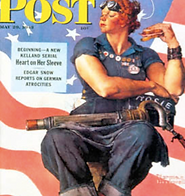The Artists Behind
Powerful Propagandas
Hans Schweitzer: Germany, 1930s
In Germany in the 1930s, propaganda was in full swing and being used by Hitler’s advisers to call the German people to arms and spread lies about the Jews. One of the most famous artists behind Nazi propaganda was Hans Schweitzer, known as "Mjolnir."

This poster shows the typical pro-Nazi theme of the German army’s strength, depicting an S.A. man standing next to a solider. The text reads, "The guarantee of German military strength!"

This next poster titled "Our Last Hope: Hitler" was used in the presidential elections of 1932, when Germany was suffering through its great depression. Nazi propagandists targeted the German people who were unemployed and living on the breadline, and they suggested Hitler as their way out, their savior.
Many posters were entitled, "He is guilty for the war." This was the key message of Hitler to start his campaign of terror and for the ethnic cleansing that ensued. Almost the entire campaign from beginning to end was driven by the artist Mjolnir. Just as the media molds public opinion today, Mjolnir most definitely molded the opinion of the German people through his designs.
Valentina Kulagina: Russia, 1930
Kulagina was one of the few female poster artists to emerge from the 20th century. Her art was heavily influenced by suprematism.

This poster, called "To Defend USSR" takes a cubist perspective in its multi-dimensional shapes, and it shows the Red army as huge almost robotic figures, marching from the factories to fight the war. They are surrounded by the tiny white airplanes of the royalists, which appear to have no effect on them at all and in fact seem to be flying through the figures.
Phillip Zec: England, 1930
Phillip Zec was probably best known for his depictions of Nazis as snakes and vultures. At the time, Nazis were usually drawn as bumbling clowns or buffoons. But Zec brought out the more sinister side of the German regime in his drawings. Hitler reportedly hated Zec so much that he added him to his blacklist and ordered his arrest following the invasion of Britain. He blamed Zec’s Jewish ancestry for his extreme ideas.

This poster by Zec was a call for women to join the war effort by working in the munitions factories.

This ugly toad is former Prime Minister of France Pierre Laval, who decided to work closely with the Nazi command during World War II.

This illustration is about the French Resistance, telling Hitler that it was very much alive.
Norman Rockwell: US, 1939
Norman Rockwell is probably one of the best known of the propaganda movement. He admitted that he was just a propaganda stooge for the Saturday Evening Post. The newspaper paid many artists and illustrators to whitewash American news with patriotism and propaganda for around 50 years. His work has often been dismissed as idealistic or sentimental.

His depiction of American life included young boys running away from a "No swimming" sign, and happy-go-lucky US citizens going about their business unaware of the crumbling world around them.

Rockwell’s famous Rosie the Riveter poster is shown, representing the American women who worked in the munitions and war supplies factories during World War II. This was a call to arms for the women of America to become strong capable females and support the war effort.

J. Howard Miller’s "We Can Do It!," commonly mistaken to depict Rosie the Riveter, conveyed the same message.